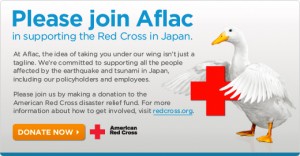Making Lemonade Out of Lemons” Turning a Potential PR Disaster into a Great Consumer Promotion
 In my previous post (click here to read Part I) I talked about the perils of a celebrity endorsement, using Gilbert Gottfried as the voice of the Aflac duck as a jumping off point. In this post I am going to look at how Aflac found a way to create a terrific consumer promotion in the aftermath of the PR problems Mr. Gottfried created by his horrendous comments following the Japan earthquake and tsunami.
In my previous post (click here to read Part I) I talked about the perils of a celebrity endorsement, using Gilbert Gottfried as the voice of the Aflac duck as a jumping off point. In this post I am going to look at how Aflac found a way to create a terrific consumer promotion in the aftermath of the PR problems Mr. Gottfried created by his horrendous comments following the Japan earthquake and tsunami.
Once Mr. Gottfried was fired and the PR folks dealt with the initial crisis management issues, Aflac needed to attend to a few issues. First, they pulled the commercials containing his voice off the air. Given that they apparently had a fairly strong media buy, they needed to quickly change their commercials. They started airing an old silent movie version with no Aflac duck voice.
With this done, they now had to find ways to revamp their image and create a new connection to their audience. They could have just let the issue die, but the duck voice was a centerpiece of their advertising, and they weren’t about to create a new creative direction. Additionally, they could have quietly found a new voice and let the whole affair slide by with no fanfare. They instead chose a direction that would create significant positive buzz, generate consumer-generated content and directly involve the consumer in the brand.
They created a consumer promotion to find the next voice of the Aflac duck. To begin promoting the search, they used the silent movie commercial to send consumers to Aflac’s Facebook page to learn about the contest. They used Monster.com to help them collect potential candidates for a contest that included both professionals and amateurs. They also set up a microsite where consumers could go to get additional information. What’s more, Aflac clearly stated that they didn’t want a Gilbert Gottfried imitator; they wanted a unique voice and interpretation. They evaluated these potential voices through auditions in 6 cities and through the online submissions.
So, what is so great about what they did? A few things:
- Effective Crisis Management: They took swift action in the form of crisis management and executed with a well-thought-out plan. It wasn’t highly reactive and yet very effective. They distanced themselves from the problem and swiftly put actions into place to show how they were moving forward away from the issues.
- Tying the Crisis Management to Promotion: Aflac turned a negative experience into a fun and consumer-interactive promotion. They created a contest where you, the consumer, could be the new Aflac voice. Now the focus was no longer Gilbert Gottfried, but the brand and how they were doing something new and cool.
- Creating an Integrated Promotion: Aflac smartly created a promotion with multiple touchpoints . These touchpoints included a microsite, social media outreach through Facebook and Twitter, PR and national advertising. Everything tied together. The PR was exceptionally well done with both print, online and TV stories talking about the contest and the new voice of Aflac.
- Continuing the Connection: The contest is now over, so the question is how to keep the conversation going. They will first generate additional publicity when they announce who the new voice is. They have also taken their Facebook page and made the focus donations to Japan to help support the victims of the earthquake and tsunami. This does a couple of things – A) shows compassion and outreach to a key customer base (remember 75% of Aflac’s business is in Asia); and B) distances themselves from the negative image of the company Mr. Gottfried potentially inflicted on them.

A few years ago I participated in some similar situations as Aflac has encountered. The hardest one was the issue surrounding BPA and its use in baby bottles. We, too, had to come up with a quick plan, but one that would create goodwill and positive promotion. In our case, we gave away one million BPA-free baby bottles. It was ambitious, but the move put our company on top as a proactive manufacturer who cared about our consumers. We used the same principles that Aflac did, and it worked very effectively.
Crisis management is tricky, and some issues are more serious than others, especially when you may be dealing with health concerns from a product recall. In Aflac’s case, it was more about consumer perception of the company, but by initiating a strong and well-thought-out plan, they were successful in changing the conversation to one that put them in a very positive light.
